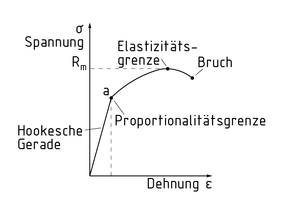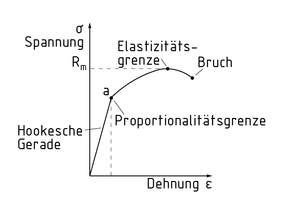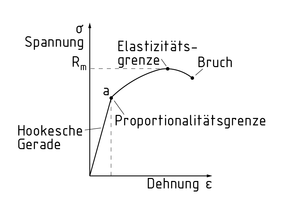
Seleccione uno
o más idiomas
0,1,3
- Alemán
- Inglés
- Chino
- Español
Ley de Hooke

La ley de Hooke describe el comportamiento lineal-elástico de un material cuando se somete a tensión o compresión. Aplica la fórmula $\sigma =E\cdot \varepsilon $ .
Los materiales se deforman cuando actúan fuerzas sobre ellos. Cuando un miembro de prueba comienza a deformarse, el esfuerzo prevaleciente $\sigma $ es proporcional a la elongación $\varepsilon $ . Este rango es referido como lineal-elástico.
En un diagrama tensión-deformación, la línea recta se extiende hasta el límite de proporcionalidad (punto a). La ley de Hooke aplica dentro de este rango. La pendiente de esta línea recta se llama módulo de elasticidad E (módulo elástico) y es una medición de la rigidez del material. Los materiales rígidos como el acero tienen un módulo de elasticidad mayor que los materiales dúctiles.
Se usan pruebas de tensión como medios experimentales para determinar el módulo de elasticidad E. Se mide la elongación, es decir, el cambio en la longitud del miembro de prueba, y los esfuerzos se calculan a partir de la fuerza de tensión que actúa en el miembro.
Línea recta en un diagrama esfuerzo-deformación que muestra el rango dentro del cual aplica la ley de Hooke
Hookesches Gesetz

Das Hookesche Gesetz beschreibt das linear-elastische Verhalten eines Werkstoffes bei Zug und Druck. Es gilt $\sigma =E\cdot \varepsilon$.
Werkstoffe verformen sich unter der Wirkung von Kräften. Am Anfang der Verformung eines Probestabes verhält sich die herrschende Spannung $\sigma$ proportional zu einer Dehnung $\varepsilon $. Dieser Bereich wird als linear-elastisch bezeichnet.
In einem Spannungs-Dehnungs-Diagramm verläuft die Hookesche Gerade bis zur Proportionalitätsgrenze (Punkt a). In diesem Bereich gilt das Hookesche Gesetz. Die Steigung dieser Geraden heißt Elastizitätsmodul E (E-Modul) und ist ein Maß für die Steifigkeit des Werkstoffes. Steife Werkstoffe wie z. B. Stahl haben einen höheren E-Modul als duktile Werkstoffe.
Der Elastizitätsmodul E wird bei Zugversuchen experimentell ermittelt. Dabei wird die Dehnung, also Längenänderung des Probestabes, gemessen. Die Spannungen werden anhand der wirkenden Zugkraft berechnet.
Hooke's law

Hooke's law describes the linear-elastic behaviour of a Material when subjected to tension and compression. The formula $\sigma =E\cdot \varepsilon $ applies.
Materials are deformed when forces act on them. When a test member starts to deform, the prevailing stress $\sigma $ is proportional to an elongation $\varepsilon $. This range is referred to as linear-elastic.
In a stress-strain diagram, the straight line extends as far as the proportionality limit (point a). Hooke's law applies within this range. The slope of this straight line is called the Modulus of elasticity E (elastic modulus) and is a measure of the material's rigidity. Rigid materials such as Steel have a higher modulus of elasticity than ductile materials.
Tensile tests are used as an experimental means of determining the modulus of elasticity E. The elongation, i.e. the change in the test member's length, is measured and the stresses are calculated based on the tensile Force acting on the member.
胡克定律

胡克定律描述了材料受到拉伸力和压缩力后产生的一种弹性形变行为。适用于公式 $\sigma =E \cdot \varepsilon $ 。
材料受到作用力时,发生形变。其伸长量(或压缩量) $\varepsilon $ 与所受应力 $\sigma $ 成正比。满足胡克定律的材料称为弹性材料
在应力-应变曲线中,材料中的应力与应变之间成线性关系,直到达到比例极限 (点 a)。胡克定律 适用于此范围。这条直线的比例系数称为弹性模量 E,其反应了材料的刚度大小。刚性材料,如钢铁的弹性模量就比韧性材料的弹性模量大。
拉伸试验可以用来确定材料的弹性模量 E 。需测量出测试材料的长度增量(即线应变),并根据作用于构件上的拉伸力计算出其应力分量。
胡克定律适用于应力-应变曲线的比例极限范围内
